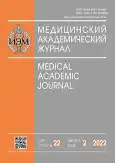The effect of heat inactivation of ferrets serum samples on the detection of SARS-CoV-2-specific IgG antibodies in elisa
- Authors: Goshina A.D.1, Matyushenko V.A.1, Donina S.A.1, Sychev I.A.1, Isakova-Sivak I.N.1, Katelnikova A.E.1,2, Rudenko L.G.1
-
Affiliations:
- Institute of Experimental Medicine
- Research and Manufacturing Company “Home of Pharmacy”
- Issue: Vol 22, No 2 (2022)
- Pages: 157-162
- Section: Conference proceedings
- URL: https://journal-vniispk.ru/MAJ/article/view/108844
- DOI: https://doi.org/10.17816/MAJ108844
- ID: 108844
Cite item
Abstract
BACKGROUND: Determination of serum antibody levels to the novel coronavirus SARS-CoV-2 is a necessary tool for assessing humoral immunity in COVID-19 patients or individuals vaccinated with specific vaccines, as well as for studying the immune responses to the viral antigens in animal models. Serum specimens of infected humans and animals are considered potentially infectious material, and therefore heat inactivation of samples at 56 °C for 1 hour is recommended to reduce the risk of infection of personnel during serological studies. However, this procedure may affect the detection of virus-specific IgG and IgM antibodies, making interpretation of the results difficult.
AIM: The goal is to evaluate the effect of heat inactivation of ferret serum samples on the binding of IgG antibodies to the SARS-CoV-2 antigens.
MATERIALS AND METHODS: Serum samples of SARS-CoV-2 naive and immune ferrets were analyzed in three variants: (1) native sera, (2) serum samples than were heated at 56°C for 1 hour, and (3) serum samples that were treated with receptor-degrading enzyme (RDE). The samples were studied in enzyme-linked immunosorbent assay (ELISA) using recombinant RBD protein (receptor-binding domain of SARS-CoV-2 S-protein) as a substrate, followed by determination of specific antibody levels before and after treatments.
RESULTS: It has been shown that heat inactivation of the ferrets’ naive serum samples can lead to false-positive results, while RDE treatment can neutralize the effect of non-specific binding of IgG antibodies to the RBD domain of the SARS-CoV-2 S protein.
CONCLUSIONS: Structural rearrangement of SARS-CoV-2-specific IgG antibodies and the formation of immunoglobulin complexes during heat inactivation of serum samples can affect the avidity of the antigen-antibody complex and lead to false-positive results when performing enzyme immunoassay. One of the possible methods to reduce the risk of “artifacts” is the treatment of blood sera with RDE, which eliminates the effect of heat inactivation.
Full Text
##article.viewOnOriginalSite##About the authors
Arina D. Goshina
Institute of Experimental Medicine
Author for correspondence.
Email: arina8goshina@gmail.com
ORCID iD: 0000-0001-5432-0171
Junior Research Associate, Laboratory of Immunology and Prophylaxis of Viral Infections, Department of Virology
Russian Federation, Saint PetersburgVictoria A. Matyushenko
Institute of Experimental Medicine
Email: matyshenko@iemspb.ru
ORCID iD: 0000-0002-4698-6085
Scopus Author ID: 57000245400
Research Associate, Laboratory of Immunology and Prophylaxis of Viral Infections, Department of Virology
Russian Federation, Saint PetersburgSvetlana A. Donina
Institute of Experimental Medicine
Email: sveta.donina@gmail.com
ORCID iD: 0000-0002-6502-8341
Scopus Author ID: 6602276916
MD, Cand. Sci. (Med.), Senior Research Associate, Laboratory of Immunology and Prophylaxis of Viral Infections, Department of Virology
Russian Federation, Saint PetersburgIvan A. Sychev
Institute of Experimental Medicine
Email: atheneem@yandex.ru
ORCID iD: 0000-0002-7115-5662
Scopus Author ID: 57202008899
ResearcherId: J-6016-2018
Junior Research Associate, Laboratory of Immunology and Prophylaxis of Viral Infections, Department of Virology
Russian Federation, Saint PetersburgIrina N. Isakova-Sivak
Institute of Experimental Medicine
Email: isakova.sivak@iemspb.ru
ORCID iD: 0000-0002-2801-1508
Scopus Author ID: 23973026600
ResearcherId: C-1034-2014
Dr. Sci. (Biol.), Head of Laboratory of Immunology and Prophylaxis of Viral Infections, Department of Virology
Russian Federation, Saint PetersburgAnastasia E. Katelnikova
Institute of Experimental Medicine; Research and Manufacturing Company “Home of Pharmacy”
Email: katelnikova.ae@doclinika.ru
ORCID iD: 0000-0003-3203-9869
ResearcherId: O-6915-2018
MD, Cand. Sci. (Med.), Research Associat, Laboratory of Immunology and Prophylaxis of Viral Infections, Department of Virology; Head of the Immunobiological Research Group
Russian Federation, Saint Petersburg; Kuzmolovsky settlement, Leningrad RegionLarisa G. Rudenko
Institute of Experimental Medicine
Email: vaccine@mail.ru
ORCID iD: 0000-0002-0107-9959
Scopus Author ID: 7005033248
ResearcherId: B-5169-2015
MD, Dr. Sci. (Med.), Professor, Head of the A.A. Smorodintsev Department of Virology
Russian Federation, Saint PetersburgReferences
- Hu B, Guo H, Zhou P, Shi ZL. Characteristics of SARS-CoV-2 and COVID-19. Nat Rev Microbiol. 2021;19(3):141–154. doi: 10.1038/s41579-020-00459-7
- V’kovski P, Kratzel A, Steiner S, et al. Coronavirus biology and replication: implications for SARS-CoV-2. Nat Rev Microbiol. 2021;19(3):155–170. doi: 10.1038/s41579-020-00468-6
- Valdés-Fernández BN, Duconge J, Espino AM, Ruaño G. Personalized health and the coronavirus vaccines — do individual genetics matter? BioEssays. 2021;43(9):2100087. doi: 10.1002/bies.202100087
- Hu X, An T, Situ B, et al. Heat inactivation of serum interferes with the immunoanalysis of antibodies to SARS-CoV-2. J Clin Lab Anal. 2020;34(9): e2341. doi: 10.1002/JCLA.23411
- Pastorino B, Touret F, Gilles M, et al. Heat inactivation of different types of SARS-CoV-2 samples: What protocols for biosafety, molecular detection and serological diagnostics? Viruses. 2020;12(7):735. doi: 10.3390/v12070735
- Hu X, Zhang R, An T, et al. Impact of heat-inactivation on the detection of SARS-CoV-2 IgM and IgG antibody by ELISA. Clin Chim Acta. 2020;509:288–292. doi: 10.1016/j.cca.2020.06.032
- Rudenko L, Kiseleva I, Krutikova E, et al. Two live attenuated vaccines against recent low–and highly pathogenic H7N9 influenza viruses are safe and immunogenic in ferrets. Vaccines (Basel). 2018;6(4):74. doi: 10.3390/vaccines6040074
- Pedersen JC. Hemagglutination-inhibition test for avian influenza virus subtype identification and the detection and quantitation of serum antibodies to the avian influenza virus. Methods Mol Biol. 2008;436:53–66. doi: 10.1007/978-1-59745-279-3_8
- Muratsugu M. Mechanism of aggregates generated by heating human serum. Biol Pharm Bull. 1996;19(1):132–135. doi: 10.1248/bpb.19.132
- Futami J, Miyamoto A, Hagimoto A, et al. Evaluation of irreversible protein thermal inactivation caused by breakage of disulphide bonds using methanethiosulphonate. Sci Rep. 2017;7(1):12471. doi: 10.1038/s41598-017-12748-y
- Ryan-Poirier KA, Kawaoka Y. Distinct glycoprotein inhibitors of influenza A virus in different animal sera. J Virol. 1991;65(1):389–395. doi: 10.1128/jvi.65.1.389-395.1991
Supplementary files






